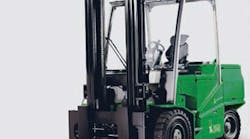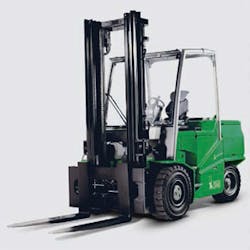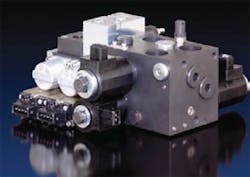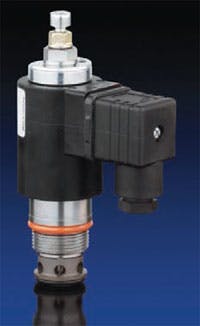HAWE Hydraulik SE, Munich, has developed a hydraulic integrated circuit for lifting functions. Dubbed the type HMPL module, it transforms hydraulic systems for forklifts with a rated bearing capacity of up to ten tons into flexible, energy-saving machines. The lifting module controls hydraulic power to lift and lower the forklift mast and is designed as a connection block for HAWE’s PSL proportional directional spool valve. The combination of both components allows simple and reliable use of all forklift functions.
The lifting module exhibits low backpressure, so lowering speed of the forks can be kept within the maximum permitted range even with no load. Plus, the forklift loses less power. The resultant energy savings means the forklift will consume less fuel or require less frequent battery charges. Heat generation is also reduced, which reduces the thermal load on all the hydraulic components.
Direct fitting of the proportional directional spool valve onto the lifting module allows implementing additional functions, such as the mast’s tilting function or sideways shifting of the fork and bale clamp. Flow rate adjustment for each function speed is simplified because the proportional directional spool valves are available in different sizes. Additional valves can be easily integrated, such as a single- or double-acting over-center valve for tilting forks backward and forward with complete control.The forklift arm is raised and lowered using a proportional directional seated valve in the lifting module. This valve can move loads with high precision at flow rates to 160 lpm (42.3 gpm). Because it is leak-free when closed, it reliably maintains pressure to securely hold loads. Lifting and lowering can be accomplished with either discrete or proportional control.
The HMPL module is designed for maximum operating pressures of 315 bar (4570 psig). It is available for variable- displacement pump systems and fixed-displacement pump systems with integrated idle circulation.
Getting the drop on lowering
HAWE also introduced a new proportional flow control valve as a space-saving alternative for load-neutral hydraulic controls. In the past, a flow controller and an electronic proportional valve had to be used for this application. Now, HAWE’s type EMC valve can be used to replace both with a single valve. Doing so saves valuable installation space for manufacturers of forklifts, lifting platforms, and similar applications.
With this valve, the drop rate of forklifts and lifting platforms remains the same at constant volume flow regardless of the load. The valve’s cone seated design provides zero leakage in the closed position to maintain pressure, which helps manufacturers comply with safety standard defined by ISO 3691.1.
The load-neutral, constant-volume flow lends itself to operator-friendly joystick control, in which operators can precisely estimate the drop rate according to the position of the joystick. The valve’s integrated pressure compensator and leak-free construction also reduce energy requirements of the application.
Type EMC is designed for a volume flow of up to a maximum of 80 lpm (21 gpm) and operating pressures up to 250 bar (3630 psig).
For more information, contact HAWE North America at www.hawe.com.
Click here for a list of more articles and products used in material handling from our Applications Tech Zone.




